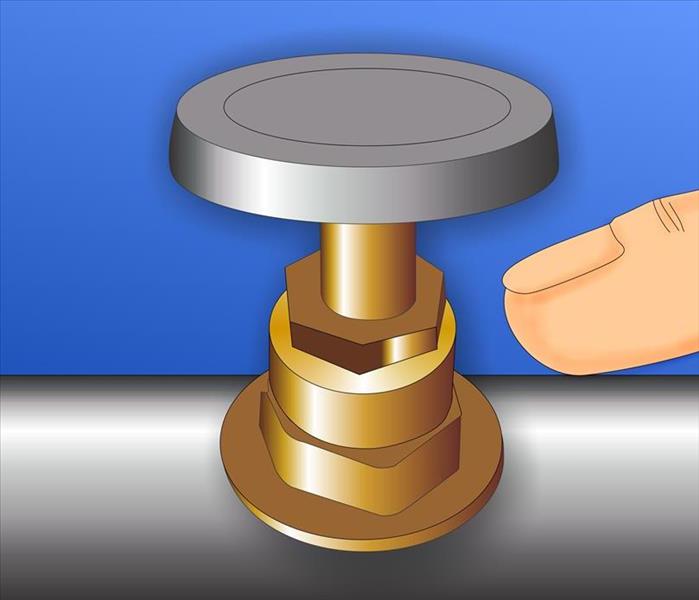HOW TO SHUT OFF ALL THE WATER DURING FLOODING
2/17/2017 (Permalink)
This article gives you instructions to:
• Shut off the main valve at the water source
• Shut off water supply valves in all parts of your home
• Check your water valves and pipes for leaks
When pipes burst, plumbing leaks, or appliances cause a flood, cut off the water at its source IMMEDIATELY. Water damage from frozen pipes, ruptured washer hoses, leaking supply lines and dripping water heaters costs billions every year. Avoid major water damage problems in your house by knowing how to shut off your water.
Take a moment right now to locate all of the shutoff valves in your home so you'll be prepared for an emergency..
How to locate the whole-house water shutoff valve -
The most important point to know in a flooding emergency is your home’s main water valve to shut off water at the source.
This valve is located around waist level or lower, on the inside basement wall, closest to your street or well, where the water comes in from outside the home.
Many water meter setups have two valves, one on the street side of the meter and one on the house side. You’ll typically find the main shutoff in the basement near the front of the house.
If you pipe in water from the city, the water meter is always mounted next to the main, and the valve itself will be large, metal and have a very sturdy handle. In a home with metered water, look for the shutoff on either side of the water meter. Your meter could be located in the basement, mounted on an exterior wall, or even out near the street in a concrete "meter pit" where the household feed line meets the utility main.
For a home served by a well, the shutoff will be on the house side of the pressure tank. You should also cut power to the tank so it doesn't detect a phantom pressure loss and burn out trying to compensate.
It could be outside your home attached to an exterior wall or in an underground box with a removable lid.
There are two types of main shutoff valves: the gate valve and the ball valve.
The gate valve is common in older homes and has a round handle that must be turned a number of times to open or close the valve. Gate valves are designed to be fully open or fully closed. Water flowing through a partially open gate valve can wear away the metal and cause the valve to fail over time.
The ball valve is more common in newer construction and has a lever handle that needs to be turned 90 degrees to turn the water on or off. You can immediately tell if it’s open or not: In the closed position, the lever is perpendicular to the pipes; in the open position it’s parallel.
If you’ve never shut off the main water valve before, test it to make sure it turned everything off. Turn on a faucet somewhere in the house and shut off the main water valve. All water flow should stop.
An old gate valve can break, so be gentle when you’re handling it. If the valve is stuck, leave it alone. If it leaks or doesn’t shut off all the way, replace the valve. You’ll need to call your water department (and possibly pay a small fee) to have the water to your house turned off at the curb stop during repairs.
If you have a well, shut off the electrical switch for the well when you leave for an extended period so it won’t pump any water while you’re gone.
Whole-house hot-water shutoff. On your water heater, there should be a valve on the hot-water outlet, which controls all of the hot water to the house. If there isn't one on yours, you or your plumber should install one.
Toilet shutoff. Look for this inline shutoff — typically a ribbed oval handle — under the toilet tank.
Sink shutoffs. These inline shutoffs usually sit just beneath the sink or within the cabinet or vanity. The one on the left is usually for the hot water, the one on the right for cold water. It could be hidden from view for asthetic reasons in your ceiling or floor, but it will still be right near the sink.
Dishwasher shutoff. Look first under the kitchen sink. Often there's a reducer coupling and shutoff valve leading to the dishwasher on the 1/2-inch hot water sink-supply line. Not there? If you have a basement, look between the ceiling joists just below the appliance.
Turning off water to the clothes washer. There should be valves where the house-supply lines meet the washer hoses. Washer hoses are notoriously weak, so always close the valves when leaving home for an extended period.
Sump pump test
Test your sump pump: Dump water down the sump pit to raise the water level, and make sure the pump is ejecting the water properly.
If you need water damage repair after you shut off the water during a flood or flooding emergency, call a qualified water damage restoration contractor and your insurance carrier.
The sprinkler system released and flooded our building. This was the weekend of our biggest event and in less than 36 hours 155 people would be in our bar area having drinks and then being served dinner in the Ball room. This meant we had less than 19 hours to get everything cleaned up. Brian and his team pulled off the impossible task, the kitchen opened at noon and the dinner went off without a hitch! ~ Vin Masotta in Branford, CT Great customer service – fast response – especially during a stressful time. Thank you! ~ Jack H. in Branford, CT
Read more testimonials from our customers >>>
RESOURCES: http://www.thisoldhouse.com/toh/article/0,,193969,00.html
http://www.familyhandyman.com/plumbing/prevent-water-damage-while-you-are-away/view-all






 24/7 Emergency Service
24/7 Emergency Service
